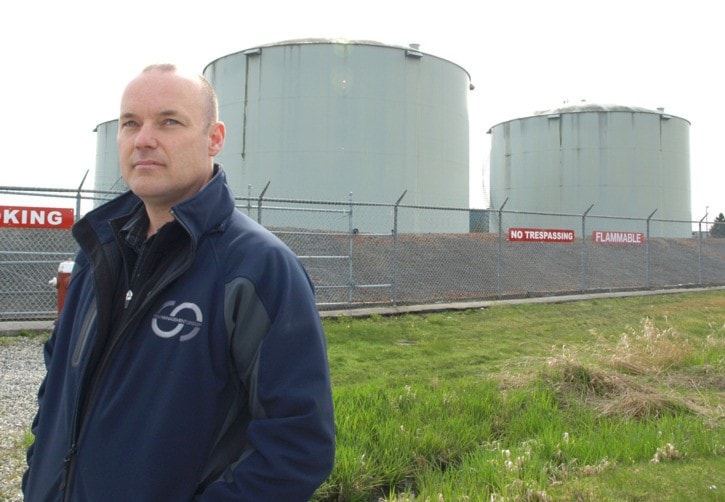It’s modern, safe and reliable, with a small environmental footprint. But critics say it’s risky and dangerous, exposing one of the world’s most important estuaries to the potential of devastating jet fuel spills.
A plan to quench Vancouver International Airport’s thirst for fuel came to light four years ago and quickly galvanized opponents. Among them, Richmond City Council, which—despite having little control in the matter—has repeatedly called on regulators to scrap the idea.
“It exposes us to environmental risk, which I believe is unnecessary given some of the alternatives that are available,” said Richmond Mayor Malcolm Brodie.
Proposed is an underground pipeline stretching up to 15 kilometres and connecting the airport with a marine terminal in South Richmond. Panamax-class tankers would transport fuel from Asia up the Fraser River’s South Arm and unload at an 80-million-litre tank farm—where the fuel’s pipeline journey across Richmond would begin.
The B.C. Environmental Assessment Office is reviewing the proposal, which requires provincial cabinet approval. Meanwhile a citizens’ group, the Vancouver Airport Pipeline Opposition for Richmond, or VAPOR, is giving politicians plenty of reasons to reject it.
“Shipping oil on water and transferring from land to ship—and then from ship to land—is risky and dangerous and does give rise to numerous spills as admitted by (the proponent’s) own studies,” said Otto Langer, a fishery biologist and member of VAPOR.
The Fraser River is a world-class salmon stream, said Langer, adding its estuary is the largest over-wintering site for waterfowl in Canada.
“Spills in water are very damaging to habitat, fish and bird life,” he said. “It is an estuary of global significance and simply the worst place to locate such a jet fuel facility.”
The group is instead advocating for a new pipeline linking the airport with local refineries, eliminating the need for tankers in the river.
 DIGITAL RENDERING: Some of the largest ships the Fraser River has ever seen will dock at a wharf in South Richmond to offload jet fuel for the Vancouver International Airport. (Vancouver Airport Fuel Facilities Corporation rendering)
DIGITAL RENDERING: Some of the largest ships the Fraser River has ever seen will dock at a wharf in South Richmond to offload jet fuel for the Vancouver International Airport. (Vancouver Airport Fuel Facilities Corporation rendering)
A half-century-old underground pipeline, owned by Kinder Morgan, connecting the airport with Burnaby’s Chevron refinery currently delivers some of the airport’s fuel. Tanker trucks deliver the rest from the Cherry Point refinery near Blaine, Wash.
Langer said the existing pipeline could be maintained and a new one built to connect the airport with Cherry Point.
“Pipelines do have leaks, accidents but at nowhere the frequency and volume of trucks, ships, barges and trains. It is the most efficient, cheapest and safest way of transporting bulk liquids,” he said. “It can be installed away from higher density people areas and sensitive habitats.”
Behind the proposal is a consortium of airlines known as the Vancouver Airport Fuel Facilities Corporation. Spokesperson Adrian Pollard said a pipeline to Cherry Point isn’t viable due to supply issues, cost, cross-border complications and a large environmental footprint.
What’s proposed is safe, a shorter pipeline than what now exists and eliminates the need for truck deliveries, which now number 1,000 per month. He also noted spill prevention and response strategies for the Fraser River “go well beyond industry standards and best practices.”
“While the risk of spills is very low, the response presence required for this project will benefit all other users in the river. In short, spill response time on the South Arm will be improved significantly because of the measures being put in place for our project.”
Pollard said the current system, where supply comes from two refineries, is unsustainable in the long term. The proposed system will have a smaller social and environmental footprint and have access to multiple sources of fuel.
Said Pollard: “The project will benefit YVR and the region for years to come.”
Airport pipeline proposal
- Underground pipeline up to 15 kilometres long, 25 to 30 centimetres in diameter, connecting airport with South Richmond
- Panamax-class tankers to offload jet fuel at wharf 15 kilometres upstream of Fraser River mouth
- Six above-ground tanks could store up to 80 million litres before entering pipeline
- Airlines say it’s needed to accommodate growth at airport, which has seen 71 per cent increase in passenger traffic and 55 per cent in cargo traffic since 1992
OIL & WATER SERIES INDEX
A Black Press series exploring the logistics, risks and politics of Kinder Morgan's proposed oil pipeline expansion.PART 1:
How safe are oil tankers travelling southern B.C. waters?
Notable accidents involving oil
Boaters concerned about more oil tanker traffic coming to Burrard Inlet
Airlines pursue Richmond pipeline to satisfy growth
PART 2:
What happens if there’s an oil spill in B.C.?
‘People of the Inlet’ oppose Kinder Morgan pipeline expansion
PART 3:
Is B.C. destined to be Alberta's oil superport?
Burnaby company in the business of disaster response![]()
Series team members on Twitter: Jeff Nagel, Wanda Chow, Todd Coyne, Sean Kolenko, Matt Hoekstra, Mario Bartel, Tom Fletcher & Chris Bryan
